The 1930s represented a transformative era in beauty and fashion, where Black women embraced elegance through stunning hairstyles that reflected both sophistication and cultural identity.
During this golden age of Hollywood glamour and jazz culture, Black women created iconic looks that defied conventions and celebrated their natural beauty with remarkable creativity.
These hairstyles weren’t merely fashion statements—they were expressions of resilience, artistry, and grace during challenging times.
Whether you’re seeking vintage inspiration for a special occasion, looking to understand the rich history of Black beauty culture, or simply wanting to explore timeless styling techniques, this comprehensive guide to 30 Beautiful 1930s Hairstyles for Black Women That Inspire Grace will take you on a journey through finger waves, pin curls, marcel waves, and other stunning styles that defined an era.
Each hairstyle tells a story of innovation, elegance, and the enduring beauty standards that Black women established nearly a century ago, many of which continue to influence modern hair trends today.
Contents
- 1 1. Classic Finger Waves with Side Part
- 2 2. Marcel Waves with Center Part
- 3 3. Pin Curl Updo with Front Waves
- 4 4. Deep Waves with Low Chignon
- 5 5. Finger Waves with Victory Rolls
- 6 6. Sleek Finger Waves with Floral Accents
- 7 7. Short Cropped Waves
- 8 8. Deep Side Part with Cascading Waves
- 9 9. Pompadour with Finger Waves
- 10 10. Wrapped Chignon with Side Waves
- 11 11. Horizontal Finger Waves
- 12 12. Temple Curls with Smooth Crown
- 13 13. Barrel Curls with Side Sweep
- 14 14. Braided Crown with Loose Waves
- 15 15. Sculptured Waves with Pearl Headband
- 16 16. Asymmetrical Waves with Decorative Combs
- 17 17. Rolled Bangs with Sleek Back
- 18 18. Soft Pin Curls All Over
- 19 19. Structured Updo with Front Wave Detail
- 20 20. Deep Waves with Side Twist
- 21 21. Graduated Waves with Nape Curls
- 22 22. Ribbon-Wrapped Waves
- 23 23. Faux Bob with Pinned Waves
- 24 24. Center Part Marcel Waves with Low Ponytail
- 25 25. Spiral Pin Curls with Side Volume
- 26 26. Wavy Bob with Curved Ends
- 27 27. Theatrical Pin Curls with Dramatic Part
- 28 28. Smooth Waves with Art Deco Hair Jewelry
- 29 29. Half-Up Waves with Back Cascade
- 30 30. Crown Braids with Finger Wave Sides
- 31 Styling Products and Techniques of the 1930s
- 32 Hair Care Practices for Maintaining 1930s Styles
- 33 Cultural Significance of 1930s Hairstyles in Black Communities
- 34 Modern Recreations and Contemporary Adaptations
- 35 Famous Black Women Who Wore 1930s Hairstyles
- 36 Tips for Achieving Authentic 1930s Looks Today
- 37 The Role of Black Beauty Salons in 1930s Culture
- 38 Comparing 1930s Hairstyles Across Different Regions
- 39 The Intersection of Fashion and Hairstyling in the 1930s
1. Classic Finger Waves with Side Part
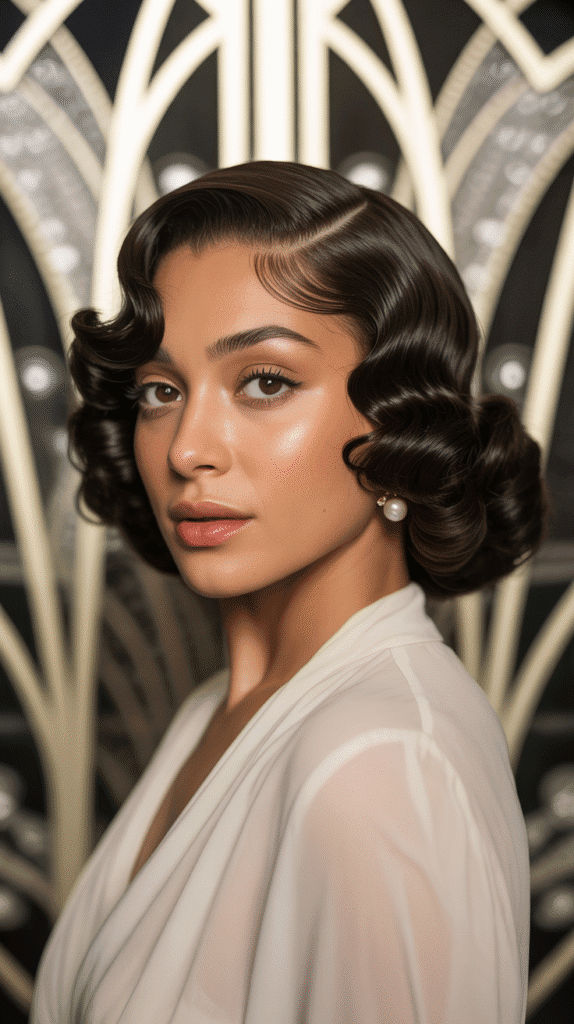
Finger waves dominated the 1930s as the most iconic hairstyle of the decade, characterized by their sculpted S-shaped curves that created a rippling effect across the hair.
Black women mastered this technique using pomades and setting lotions to achieve smooth, glossy waves that framed the face beautifully.
- The side part finger wave created an asymmetrical elegance that became synonymous with 1930s sophistication and red-carpet glamour.
- This style required skilled hands to mold the hair into uniform waves using only fingers, combs, and styling products without heat tools.
- Black women adapted this technique to work with various hair textures, often pressing the hair first to achieve the sleek finish necessary for defined waves.
- The waves typically started at the hairline and continued throughout the length of the hair, creating a fluid, sculptural appearance.
- This hairstyle was particularly popular for evening events and formal occasions, paired with elegant gowns and statement jewelry.
- Modern recreations of this style use setting gels, wave clips, and careful sectioning to achieve the authentic 1930s appearance.
2. Marcel Waves with Center Part
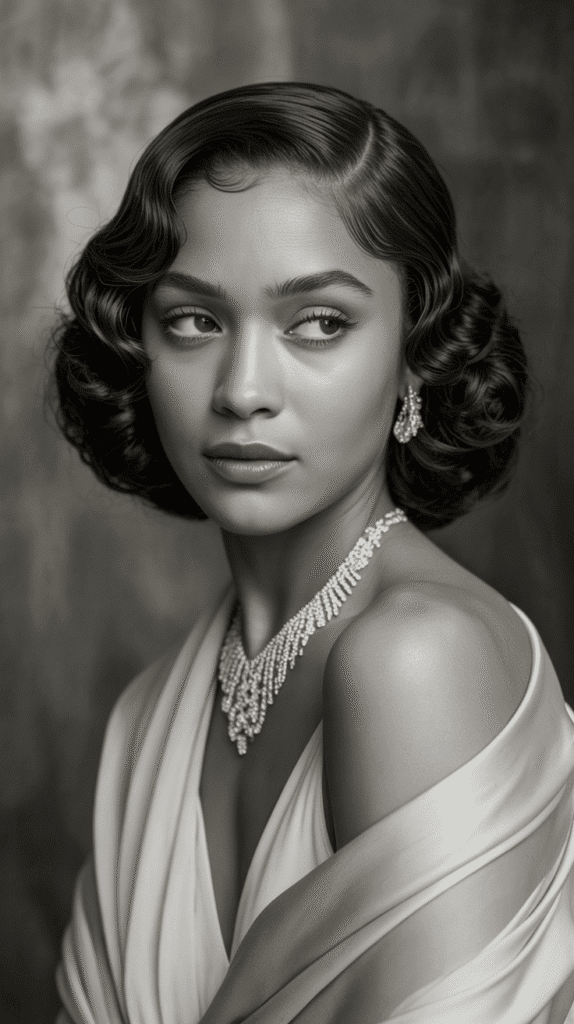
Marcel waves, created using heated curling irons, offered a more relaxed alternative to the structured finger waves while maintaining the characteristic wave pattern of the era.
This technique was named after French hairdresser Marcel Grateau and became widely adopted in Black salons.
- The center part marcel wave provided perfect symmetry, framing both sides of the face equally with soft, flowing waves.
- This method involved using marcel irons heated on stoves to create consistent wave patterns throughout the hair.
- Black hairstylists became experts at controlling temperature and timing to avoid heat damage while achieving beautiful results.
- The waves created by this technique were typically looser and more voluminous than finger waves, giving a softer overall appearance.
- Women often wore this style for daytime activities, as it required less maintenance than the more structured finger wave styles.
- The technique involved rotating the iron while moving through sections of hair, creating the distinctive wave pattern.
- This hairstyle worked particularly well for women with longer hair who wanted movement and texture without sacrificing elegance.
3. Pin Curl Updo with Front Waves
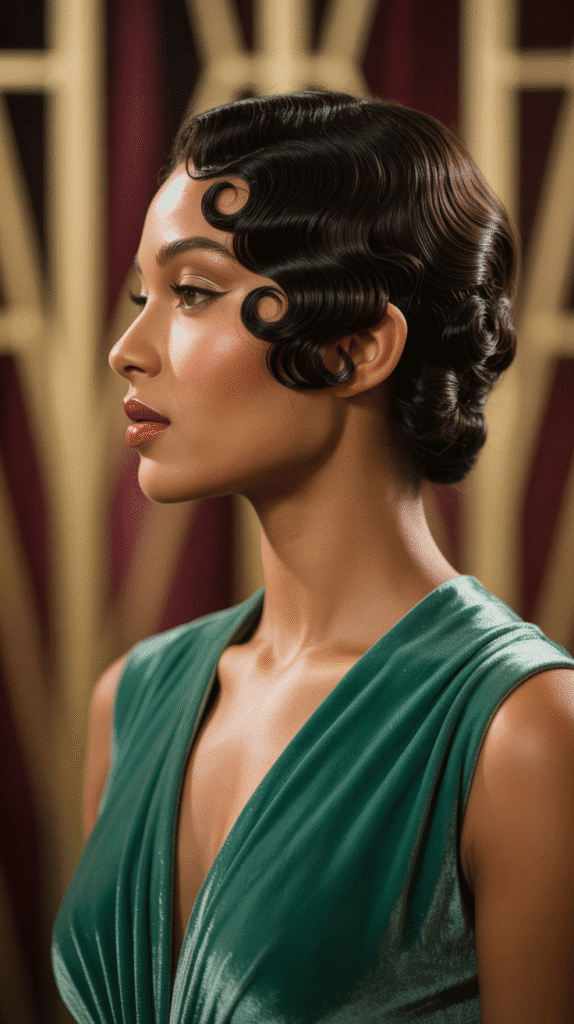
Pin curls formed the foundation of many 1930s hairstyles, creating tight curls that could be brushed out for volume or arranged into elaborate updos.
The combination of front waves with pinned back sections created a versatile and elegant look.
- Pin curls were created by wrapping small sections of damp hair around the finger and securing them flat against the scalp with bobby pins.
- This technique allowed women to create various styles from a single set, making it economical and practical for everyday wear.
- The front waves provided the characteristic 1930s elegance while the updo kept hair neat and professional for work settings.
- Black women often set their pin curls overnight using wave caps or silk scarves to protect the style.
- The curls could be arranged into different patterns—flat against the head for sleek styles or standing on end for more volume.
- This versatile technique allowed for creativity, with women designing unique patterns that showcased their individual styling skills.
- The style remained popular throughout the decade because it worked well for various occasions, from casual outings to formal events.
4. Deep Waves with Low Chignon
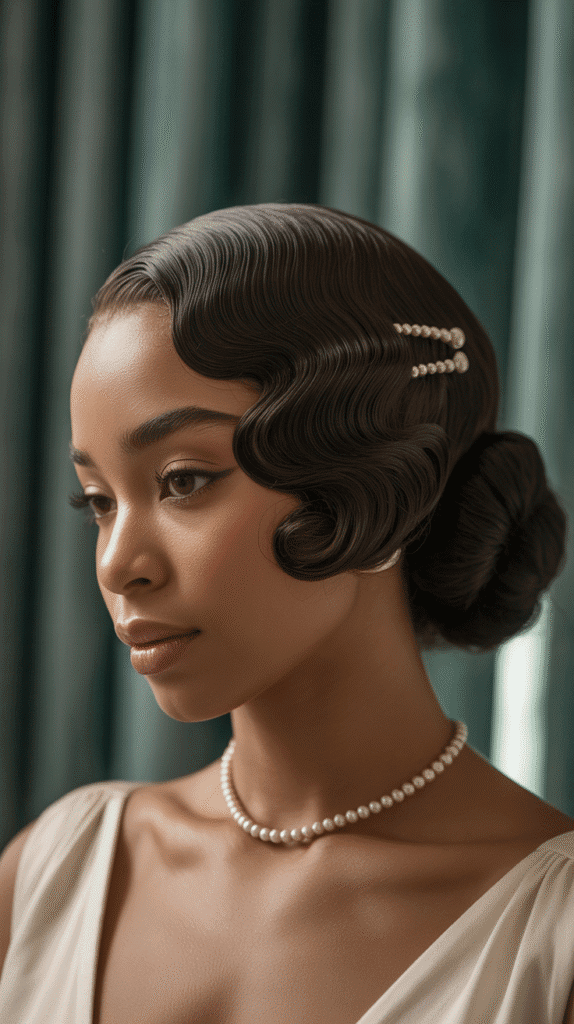
The combination of deep sculpted waves transitioning into a low chignon represented the height of 1930s sophistication and grace.
This style elegantly balanced structured front styling with a soft, romantic back.
- The deep waves at the crown and sides created dramatic dimension and showcased the sculpting skills of the stylist.
- The low chignon, positioned at the nape of the neck, provided a classic finishing touch that emphasized neck and shoulder lines.
- This hairstyle was particularly popular for wedding ceremonies and formal evening events in the Black community.
- The contrast between the structured waves and soft bun created visual interest and demonstrated advanced hairstyling techniques.
- Women often adorned the chignon with decorative combs, flowers, or jeweled accessories for added elegance.
- The style required hair of at least shoulder length, though extensions and added hairpieces were commonly used to achieve fuller looks.
- Maintenance involved refreshing the waves with pomade and ensuring the chignon remained smooth and secure throughout the day.
5. Finger Waves with Victory Rolls
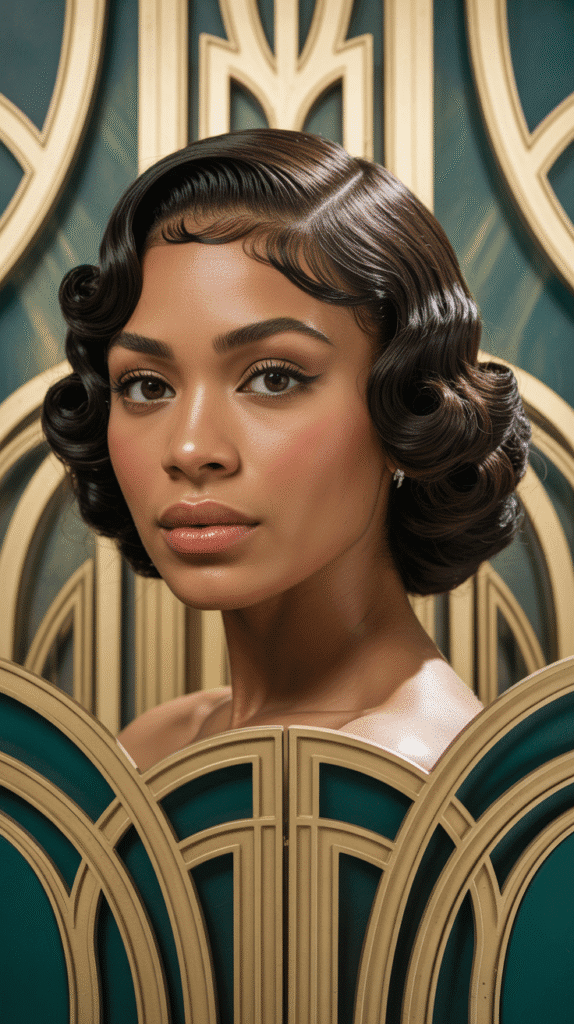
Victory rolls, which would become even more popular in the 1940s, had their origins in the late 1930s when women began experimenting with rolled sections at the front hairline.
Combined with finger waves, this created a dramatic and patriotic style.
- The victory rolls involved rolling sections of hair upward and backward from the face, creating cylindrical shapes above the forehead.
- These rolls could be worn symmetrically on both sides or asymmetrically with a single roll on one side.
- The remaining hair was typically styled in finger waves that flowed from the rolls to the nape of the neck.
- Black women adapted this style using pressing techniques and strong-hold pomades to maintain the shape throughout the day.
- The dramatic height created by victory rolls added stature and presence, making it popular among performers and entertainers.
- This style required significant skill to execute properly, with each roll needing to be perfectly smooth and secured with bobby pins hidden inside.
- The combination created a look that was both sophisticated and bold, perfect for women who wanted to make a statement.
6. Sleek Finger Waves with Floral Accents
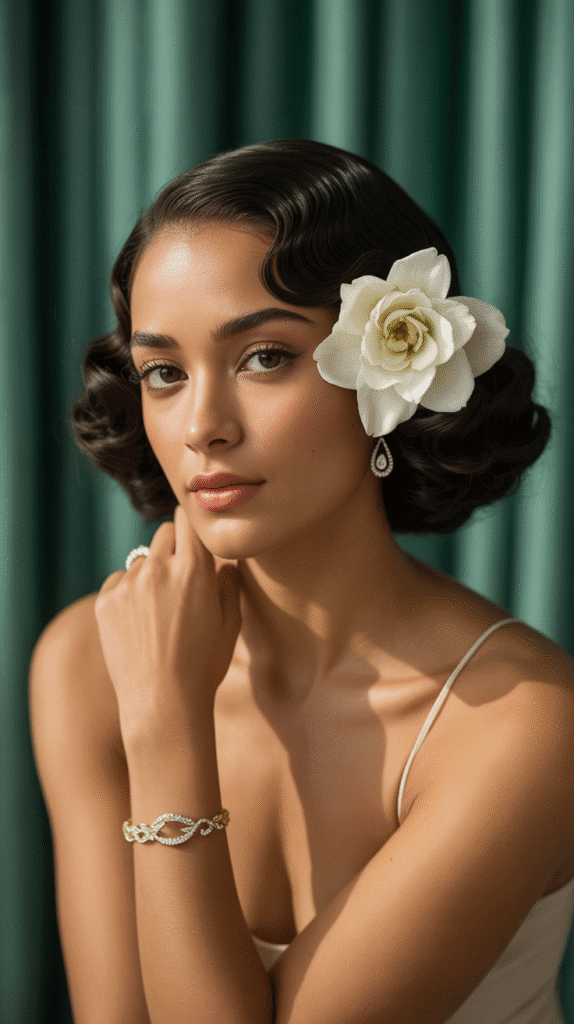
Adding floral embellishments to finger wave hairstyles elevated the look from everyday elegance to special occasion glamour.
Fresh flowers or silk replicas were carefully positioned to complement the wave pattern.
- Flowers were typically placed on the side opposite the part, creating balance and drawing attention to the face.
- Popular choices included gardenias, roses, orchids, and camellias, with white flowers being especially favored for their contrast against dark hair.
- The positioning of flowers required careful consideration to enhance rather than disrupt the wave pattern.
- This style was particularly popular for summer garden parties, weddings, and evening social events in Black communities.
- The combination of sculpted waves and natural floral beauty created a romantic, feminine aesthetic.
- Flowers were secured using bobby pins or small combs, ensuring they remained in place throughout the event.
- Modern interpretations often use fabric flowers or decorative hair accessories that capture the same vintage romance.
7. Short Cropped Waves
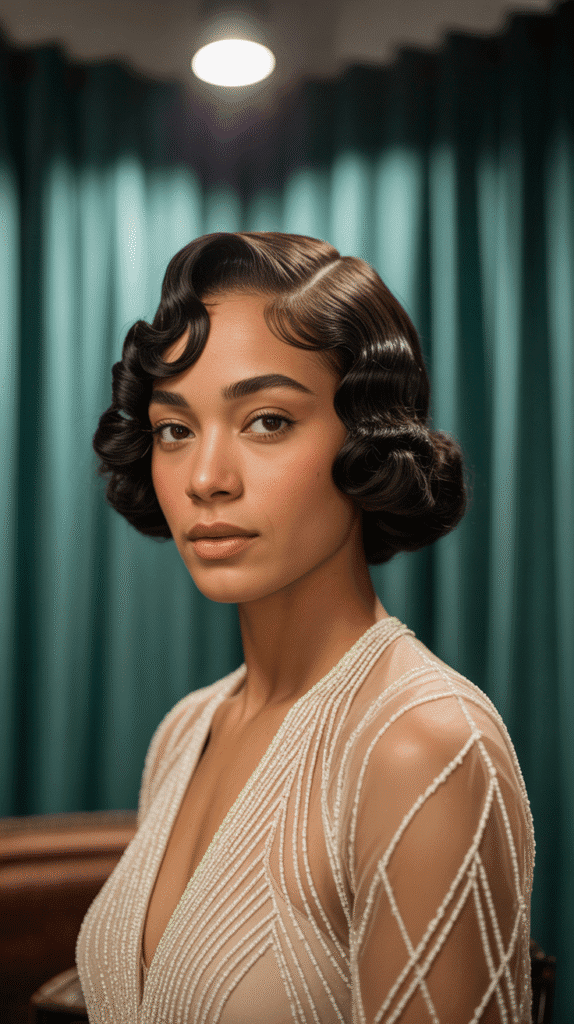
Not all 1930s styles required long hair—short cropped waves offered a modern, progressive look that challenged traditional beauty standards.
This bold style was favored by working women and those influenced by the flapper movement’s continuing impact.
- Short cropped waves typically ended at or above the ear, creating a neat, professional appearance that was practical for working women.
- The hair was still waved using finger wave or marcel wave techniques, maintaining the era’s characteristic sculptural quality.
- This style emphasized facial features and required confidence to wear, as it drew all attention to the face.
- Black women who chose this style often worked in entertainment, domestic service, or other fields where long hair was impractical.
- The short length required frequent salon visits to maintain shape and keep waves looking fresh and defined.
- Styling products like pomades and wave creams were essential to keep the short waves in place throughout the day.
- This progressive style represented independence and modernity, appealing to women who embraced change and challenged conventions.
8. Deep Side Part with Cascading Waves
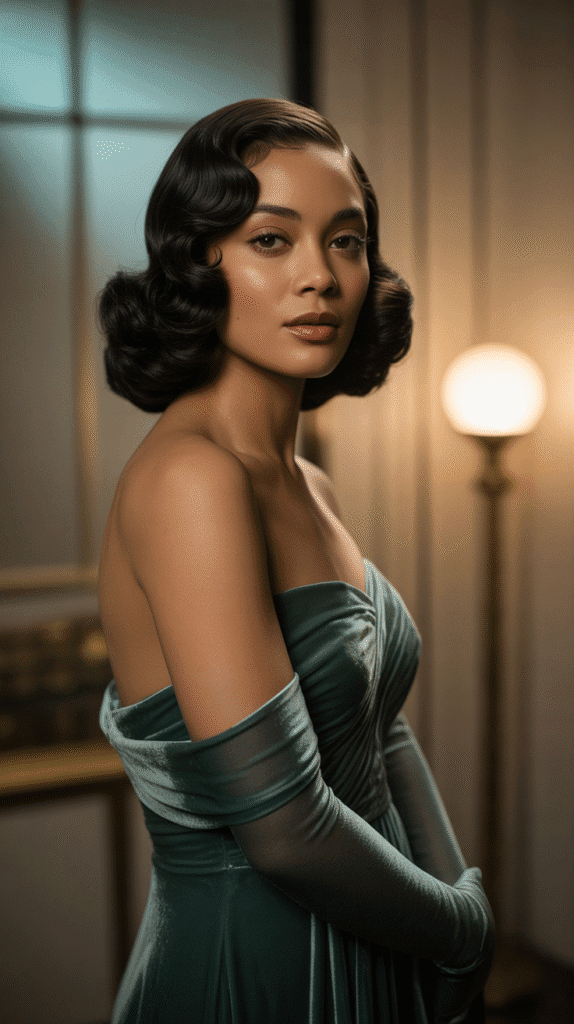
The deep side part with cascading waves created a dramatic, asymmetrical look that showcased the natural flow and movement of waved hair.
This style emphasized one side of the face while creating volume and dimension.
- The part was positioned far to one side, often near the temple, creating a striking division between the two sides of the hairstyle.
- The larger section featured multiple wave layers that cascaded down, creating depth and movement.
- The smaller section was typically pinned back or styled flat against the head, emphasizing the contrast.
- This style worked particularly well for women with longer hair who wanted to showcase length while maintaining 1930s elegance.
- The cascading effect required careful wave formation to ensure each layer flowed naturally into the next.
- Black hairstylists achieved this look by sectioning the hair horizontally and creating waves in each section before allowing them to overlap.
- The dramatic side-swept appearance was perfect for photography and stage performances, where visual impact was important.
9. Pompadour with Finger Waves
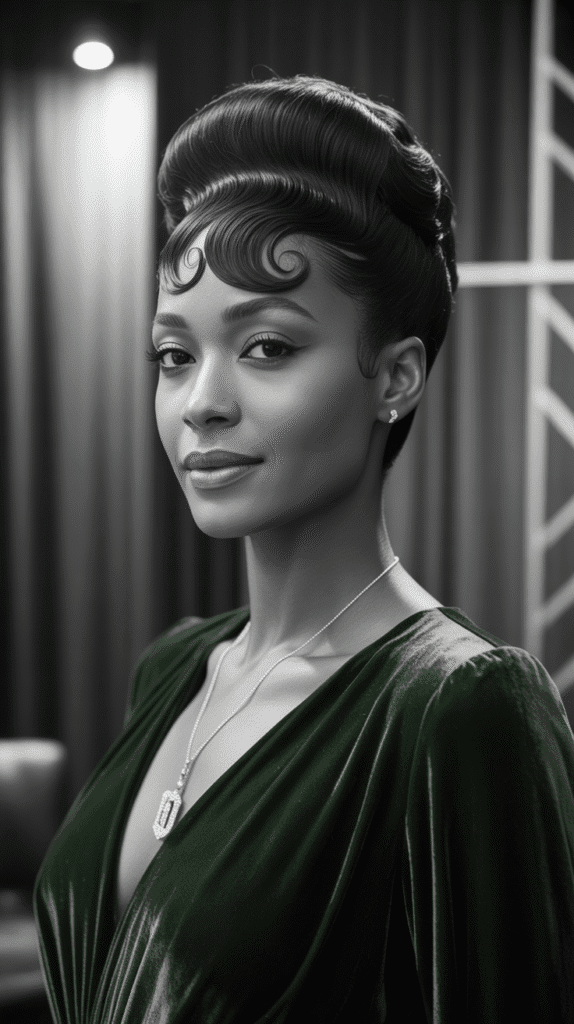
The pompadour, traditionally associated with men’s hairstyling, was adapted by women in the 1930s to create height and drama at the front hairline.
Combined with finger waves, this created a regal, sophisticated appearance.
- The pompadour section at the front was rolled back and upward, creating height and drawing the eye upward to elongate the face.
- Behind the pompadour, the hair was styled in traditional finger waves that flowed to the sides and back.
- This style required significant volume at the crown, often achieved through backcombing or the use of padding underneath.
- Black women enhanced this look with strong-hold pomades and setting lotions that maintained the lift throughout the day.
- The pompadour height varied from subtle to dramatic depending on personal preference and occasion.
- This style was particularly flattering for round face shapes as it added vertical dimension and created balance.
- The combination of height and sculptural waves created a commanding presence perfect for formal occasions and professional settings.
10. Wrapped Chignon with Side Waves
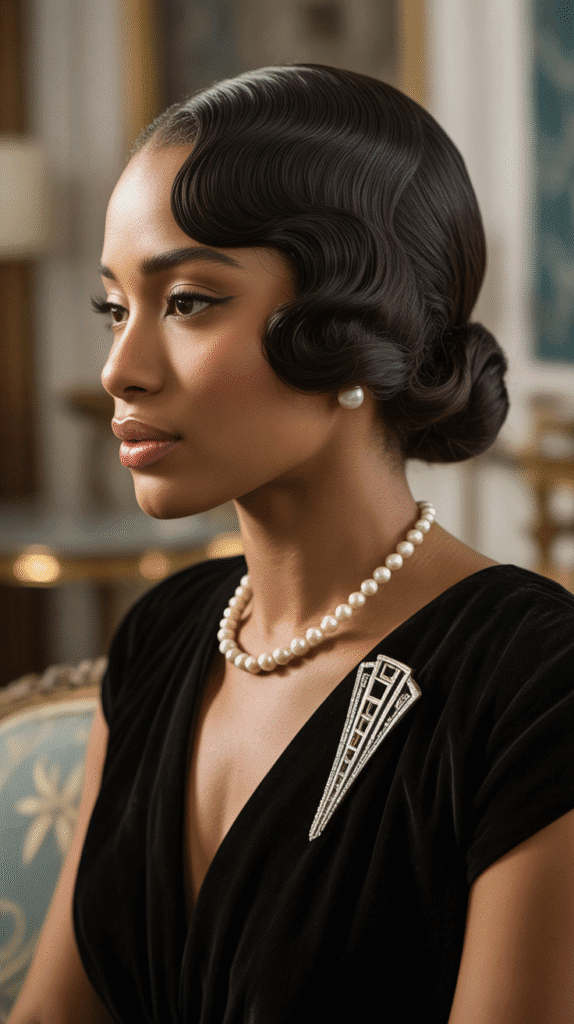
The wrapped chignon combined the elegance of an updo with the characteristic waves of the 1930s, creating a sophisticated style suitable for both day and evening wear.
This versatile look was popular across all social classes.
- The side sections were styled in finger waves or marcel waves that framed the face beautifully.
- The remaining hair was gathered at the nape or back of the head and wrapped around itself to create a smooth, rounded bun.
- The wrapping technique involved twisting the hair section as it was wrapped, creating a rope-like texture that added visual interest.
- This style was practical for women with various hair lengths, as shorter hair could be supplemented with hairpieces or switches.
- The chignon could be positioned low for a conservative look or higher for more drama and formality.
- Black women often decorated the chignon with ornamental combs, pins, or netting for added sophistication.
- The style kept hair secure and neat for long periods, making it ideal for working women and those with active lifestyles.
11. Horizontal Finger Waves
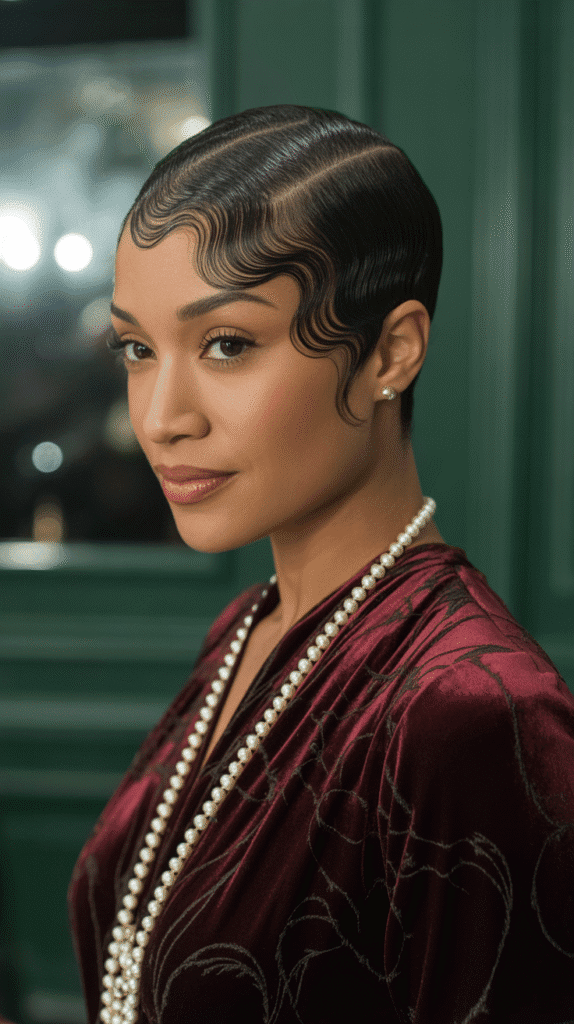
Horizontal finger waves created a distinctive striped appearance as the waves ran parallel across the head from side to side.
This geometric approach to finger waving showcased technical precision and created a modern, architectural look.
- Unlike traditional diagonal or vertical waves, horizontal waves emphasized width rather than length, creating a unique visual effect.
- This style worked particularly well for women with shorter to medium-length hair who wanted maximum impact.
- The waves were formed by sectioning the hair horizontally and creating S-curves that aligned perfectly across each section.
- Achieving uniform horizontal waves required exceptional skill, as each wave needed to align perfectly with those above and below it.
- This style appeared frequently in fashion photography and advertisements, representing the height of 1930s modernity.
- The geometric precision of horizontal waves complemented the Art Deco aesthetic that dominated the era’s visual culture.
- Black hairstylists who mastered this technique were highly sought after, as it demonstrated superior technical ability.
12. Temple Curls with Smooth Crown
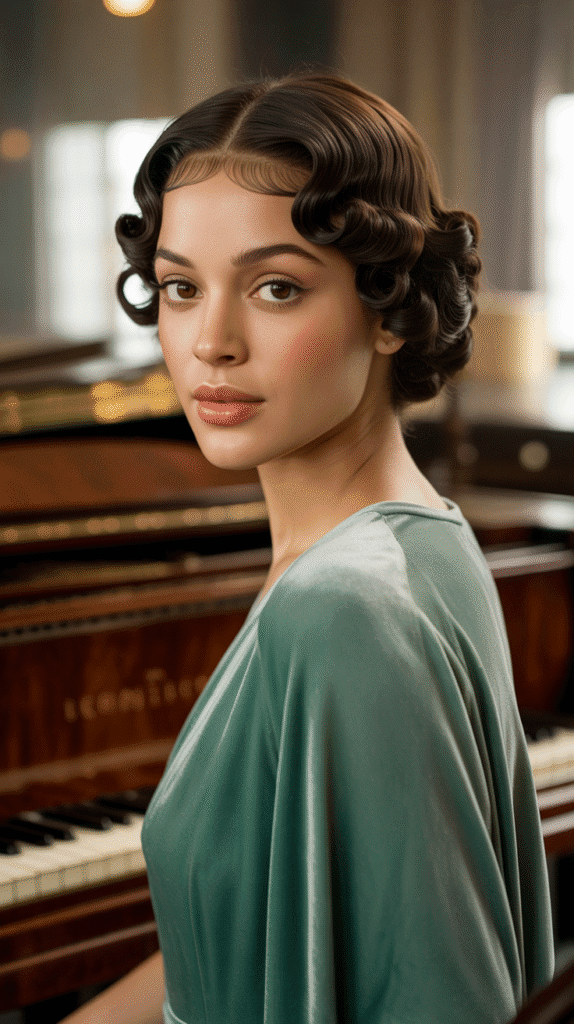
Temple curls, also known as kiss curls or spit curls, were small curl sections placed strategically at the temples or along the hairline.
Combined with a smooth, sleek crown, this created a romantic yet refined appearance.
- The temple curls were typically small, tight spirals that added delicate detail and framed the face softly.
- These curls were formed by wrapping small sections of hair around the finger and pinning them in place until set.
- The crown section was smoothed down using pomades and brushes, creating contrast with the textured curls.
- This style was particularly popular for evening wear and romantic occasions within the Black community.
- The placement of temple curls could vary, with some women wearing them on both sides and others placing them asymmetrically.
- The combination of smooth and curled sections demonstrated styling versatility and attention to detail.
- This look required minimal hair length, making it accessible to women with shorter cuts who still wanted feminine details.
13. Barrel Curls with Side Sweep
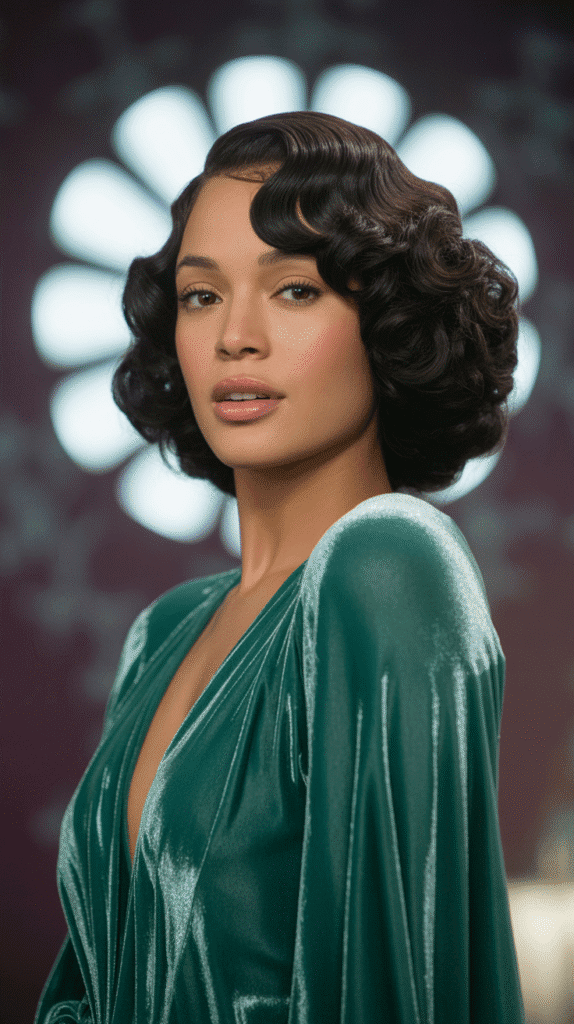
Barrel curls, larger than pin curls but more defined than loose waves, created volume and movement throughout the 1930s.
When swept to one side, this style combined structure with romantic flow.
- Barrel curls were created by wrapping larger sections of hair around curling rods or the fingers, creating cylindrical curl shapes.
- These curls were typically brushed out partially to create soft waves with more body than traditional finger waves.
- The side sweep gathered all or most of the hair to one side, creating asymmetry and showcasing the curl pattern.
- This style was particularly flattering for formal photographs, as it created dimension and caught light beautifully.
- Black women achieved lasting hold by setting the barrel curls on damp hair and allowing them to dry completely before brushing.
- The volume created by barrel curls made this style popular for women who wanted fuller-looking hair.
- This technique provided a softer alternative to the crisp, defined waves that dominated early 1930s styling.
14. Braided Crown with Loose Waves
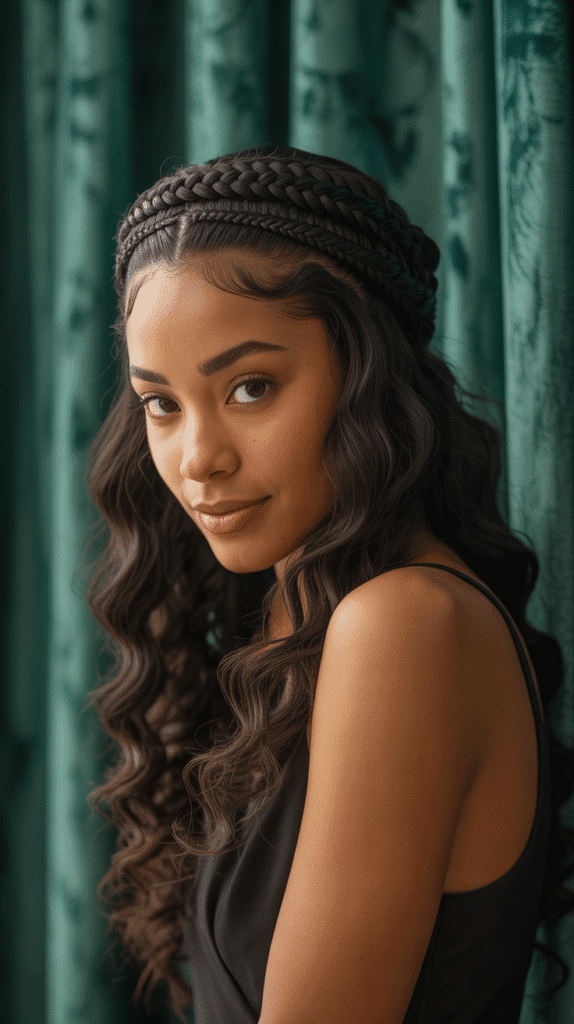
The braided crown hairstyle incorporated traditional braiding techniques into 1930s styling, creating a halo effect that was both practical and beautiful.
Loose waves fell from the crown, combining structure with movement.
- The braided crown was formed by braiding sections of hair from both sides and wrapping them around the head like a coronet.
- This technique kept hair off the face while creating a romantic, almost ethereal appearance.
- The remaining hair hung in loose waves or curls, styled using marcel waves or pin curl techniques.
- This style held particular cultural significance, as braiding had deep roots in African and African American hair traditions.
- The crown could be created with a single braid, multiple small braids, or twisted sections depending on personal preference.
- This versatile style worked for both casual daytime wear and formal evening events depending on how the loose sections were styled.
- Black women often adorned the braided crown with decorative pins, ribbons, or small flowers for special occasions.
15. Sculptured Waves with Pearl Headband
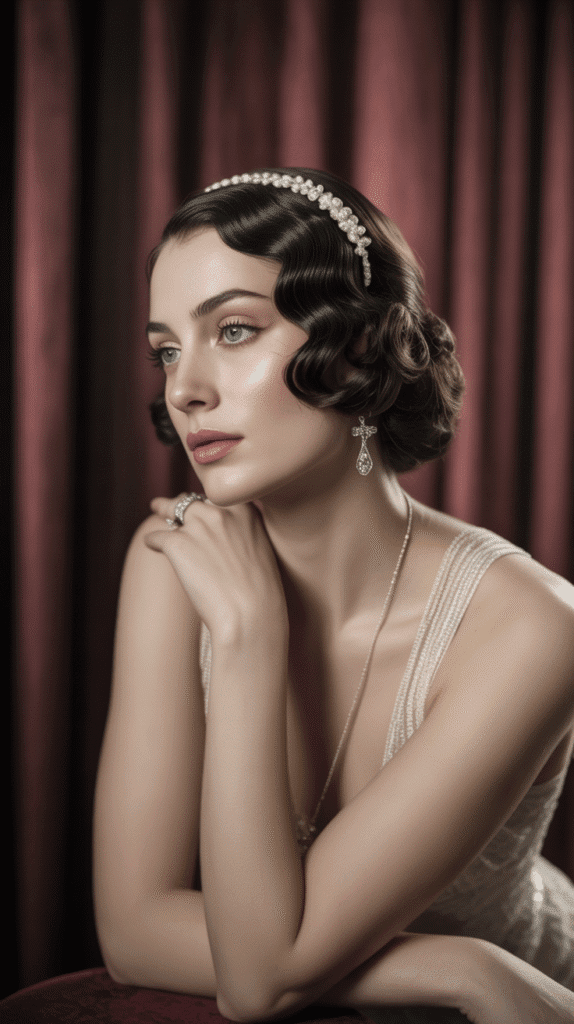
Pearl headbands and decorative hair accessories were essential elements of 1930s fashion, and when paired with sculptured waves, they created an opulent, luxurious look.
The accessories enhanced rather than overwhelmed the hairstyle.
- Pearl headbands were positioned across the forehead or farther back on the crown, depending on the desired effect.
- The waves were carefully arranged to flow harmoniously with the headband placement, creating cohesive styling.
- These accessories were particularly popular for evening events, weddings, and formal social gatherings in Black society.
- The pearls reflected the Art Deco love of luxury and geometric design, complementing the sculptural nature of finger waves.
- Women of various economic backgrounds wore these accessories, with options ranging from real pearls to affordable glass beads.
- The headband helped secure the waves in place while adding a glamorous finishing touch to the overall look.
- Modern recreations of this style often use vintage-inspired headbands to achieve authentic 1930s aesthetics.
16. Asymmetrical Waves with Decorative Combs
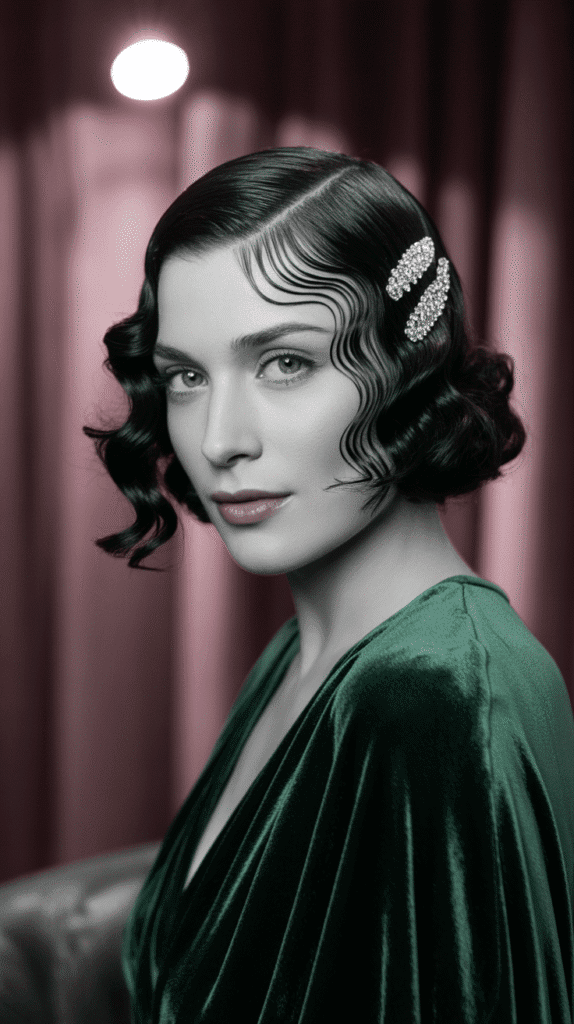
Asymmetrical waves created visual interest through deliberate imbalance, with one side styled differently from the other.
Decorative combs anchored the style and added artistic elements.
- The asymmetry was achieved through different wave depths, varying part placements, or contrasting styling techniques on each side.
- Decorative combs, often featuring rhinestones, metalwork, or intricate designs, were placed strategically to enhance the asymmetry.
- This style allowed women to showcase their creativity and personal aesthetic preferences.
- The combs served both functional and decorative purposes, holding hair in place while adding sparkle and visual interest.
- Black hairstylists designed custom asymmetrical patterns for clients, creating one-of-a-kind looks for special occasions.
- This style was particularly popular in urban centers where fashion-forward Black women embraced bold, artistic expressions.
- The combination of structured waves and ornamental combs represented the intersection of technical skill and artistic vision.
17. Rolled Bangs with Sleek Back
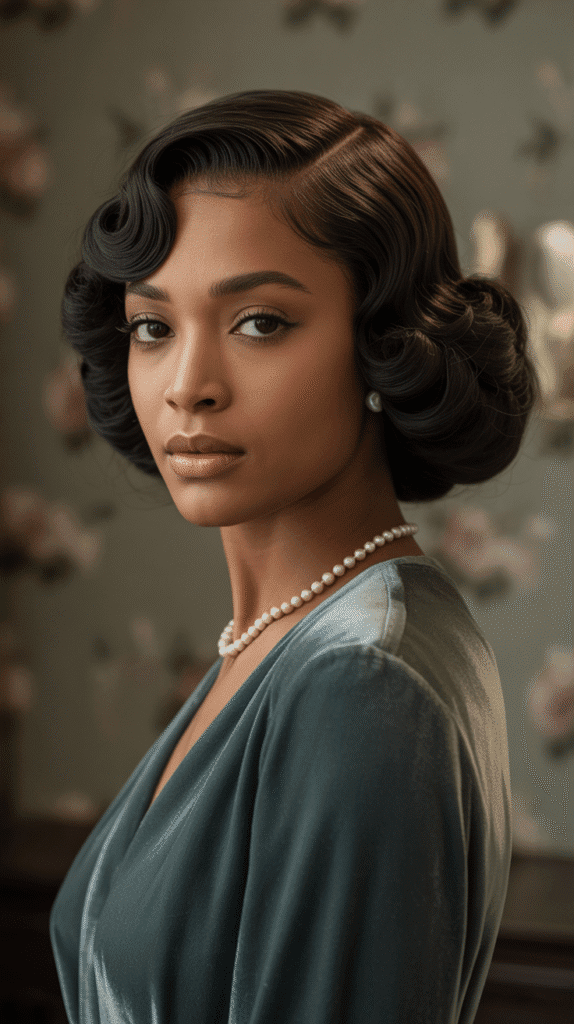
Rolled bangs created volume and focus at the front hairline while the sleek back maintained sophistication and practicality.
This two-part style offered versatility and timeless appeal.
- The front section was rolled upward and backward, creating a cylindrical shape similar to victory rolls but typically fuller and rounder.
- The remaining hair was smoothed straight back and could be left down, gathered into a ponytail, or secured in an updo.
- This style worked particularly well for Black women with thick, dense hair that created impressive volume when rolled.
- The contrast between the voluminous front and sleek back created a balanced, elegant silhouette.
- Strong-hold pomades and setting lotions were essential to maintain the rolled section throughout the day.
- This style was practical for work environments while remaining stylish enough for social occasions.
- The height created by the rolled bangs helped elongate the face and draw attention to the eyes.
18. Soft Pin Curls All Over
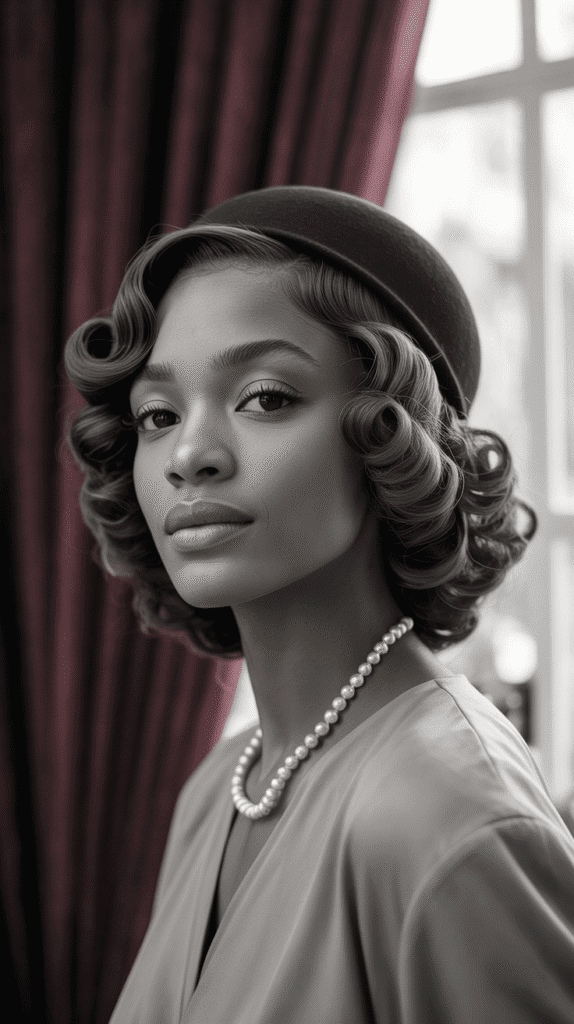
An all-over pin curl set created a foundation of uniform curls that could be styled in countless ways.
This technique was fundamental to 1930s hairstyling and provided maximum versatility.
- Pin curls were set throughout the entire head in consistent sizes and directions to create uniform curl pattern.
- Once dry and brushed out, these curls created soft, voluminous waves that moved naturally.
- The direction of the pin curls determined the final wave pattern and flow of the hairstyle.
- This technique was economical and practical, allowing women to create salon-quality results at home.
- Black women often set pin curls before bed, sleeping in wave caps to protect the set overnight.
- The brushed-out curls could be arranged into updos, left loose, or styled into structured waves depending on the occasion.
- This versatile foundation allowed for creative expression and adaptation to changing beauty trends.
19. Structured Updo with Front Wave Detail
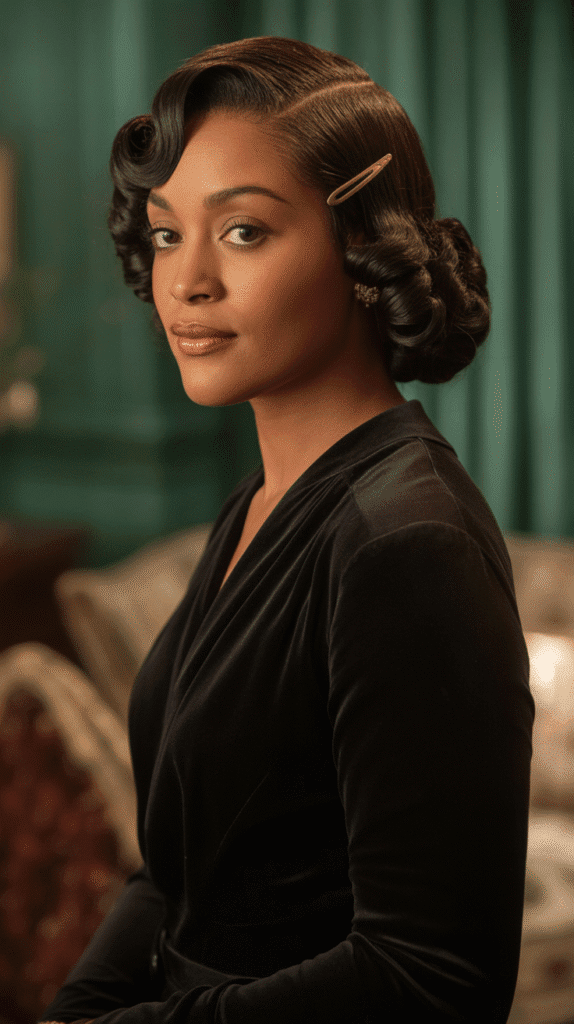
Structured updos combined the practical need to keep hair secured with the aesthetic demands of 1930s elegance.
Front wave details ensured the style remained true to the era’s characteristic look.
- The front section featured carefully sculpted finger waves or marcel waves that framed the face.
- The remaining hair was gathered into a structured bun, twist, or coil at the back or crown of the head.
- This style was particularly popular among professional women, domestic workers, and those in service industries.
- The updo kept hair neat and manageable throughout long workdays while maintaining an elegant appearance.
- Various bun shapes were used, from smooth rounded buns to more intricate braided or twisted designs.
- The front waves provided the signature 1930s aesthetic while the updo offered practicality and longevity.
- This style represented the balance Black women struck between beauty standards and practical lifestyle needs.
20. Deep Waves with Side Twist
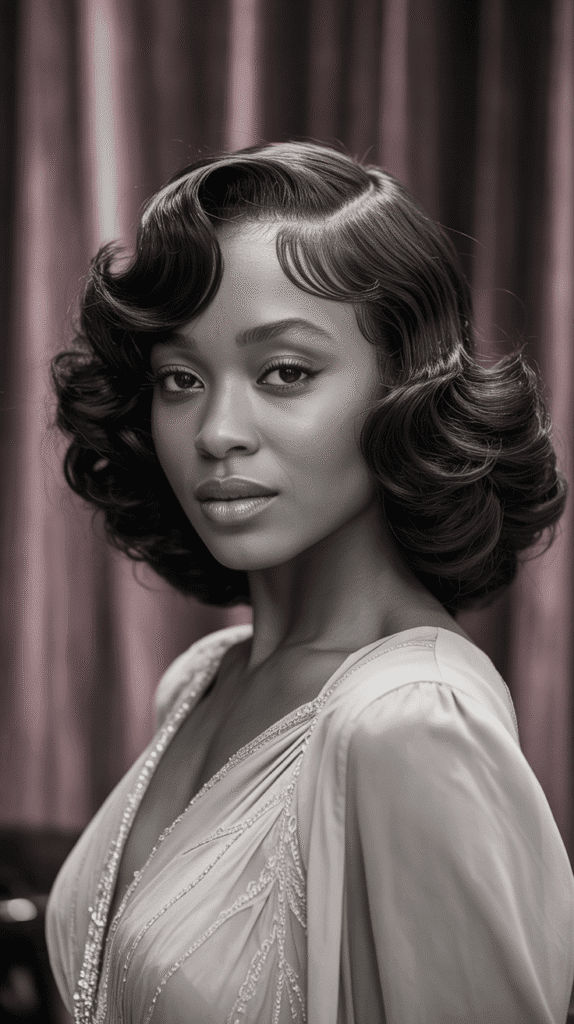
The side twist added dimension and movement to deep waves, creating a style that was both structured and dynamic.
This combination showcased advanced styling techniques and artistic vision.
- Deep waves were formed using finger wave or marcel wave techniques, creating pronounced S-curves with dramatic definition.
- A section of hair on one or both sides was twisted rope-like and incorporated into the wave pattern or pinned back.
- The twist added three-dimensional interest and broke up the uniform wave pattern with textural contrast.
- This style required careful planning to ensure the twisted sections complemented rather than competed with the waves.
- Black hairstylists used this technique to create signature looks for clients preparing for special events.
- The combination demonstrated mastery of multiple techniques within a single hairstyle.
- This style worked well for medium to long hair lengths and could be adapted for various face shapes.
21. Graduated Waves with Nape Curls
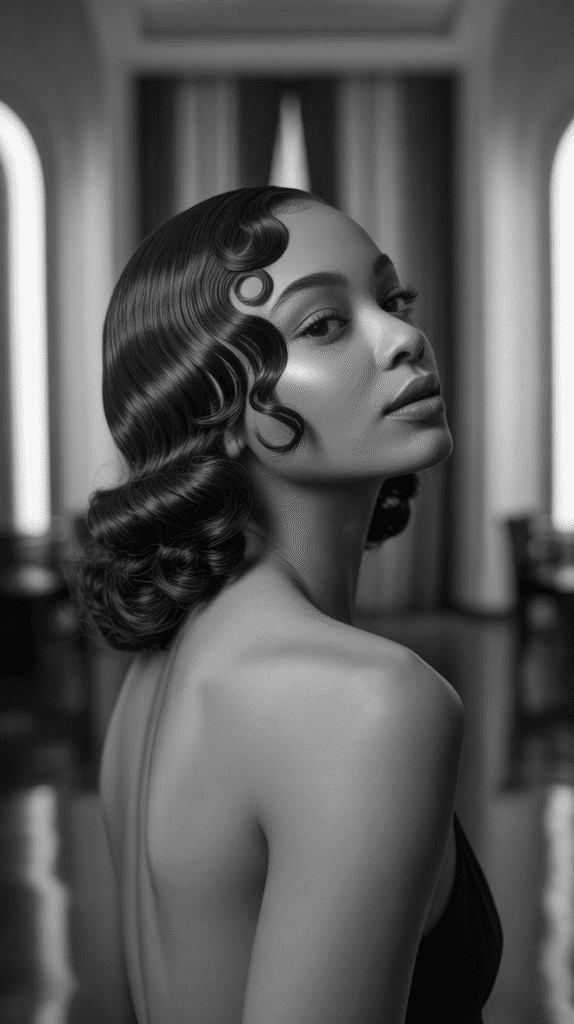
Graduated waves transitioned from larger, looser waves at the crown to smaller, tighter waves and curls at the nape.
This progression created visual interest and showcased styling versatility.
- The graduated effect was achieved by varying wave depth and curl size throughout different sections of the hair.
- Crown sections featured broader, more relaxed waves that provided volume and framing.
- Middle sections showed medium waves that created transition and flow.
- The nape area featured tight pin curls or ringlets that added delicate detail and femininity.
- This technique demonstrated advanced skills as it required managing multiple curl sizes and patterns cohesively.
- The style was particularly flattering when worn with updos that revealed the graduated nape curls.
- Black women often wore this style for formal events where all angles of the hair would be visible.
22. Ribbon-Wrapped Waves
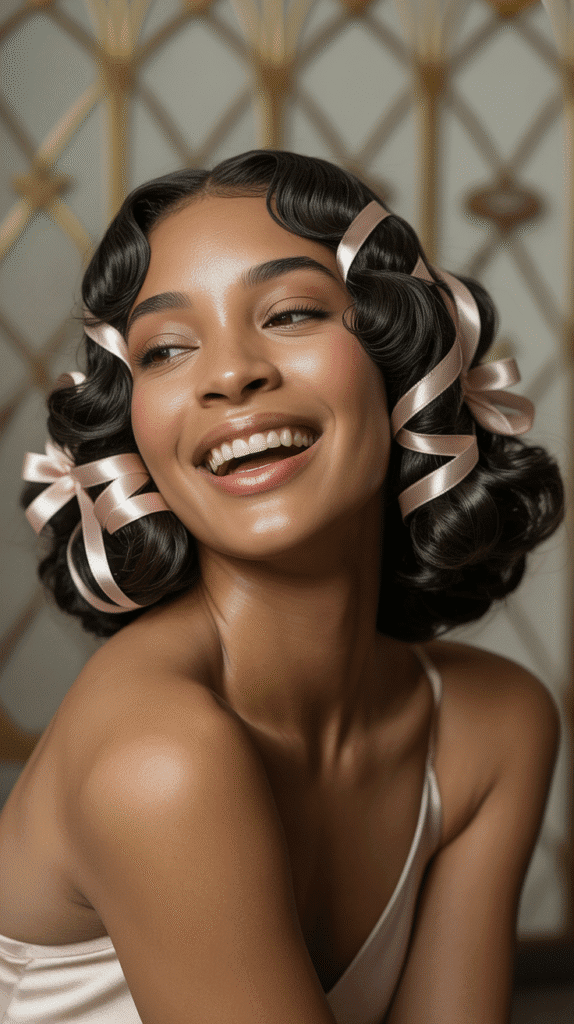
Ribbons added color, texture, and whimsy to 1930s hairstyles while serving the practical purpose of helping secure waves and curls.
Ribbon-wrapped waves combined functionality with decorative beauty.
- Ribbons were woven through wave sections, wrapped around curl formations, or used to secure portions of the hairstyle.
- Popular ribbon colors included black, deep jewel tones, and pastels depending on the occasion and outfit.
- The ribbons could be left visible as decorative elements or hidden beneath waves to provide structure.
- This technique was particularly popular for younger women and for festive occasions like parties and celebrations.
- Satin and velvet ribbons were preferred for their luxurious appearance and ability to grip hair effectively.
- The ribbon placement was carefully planned to enhance the wave pattern without overwhelming the hairstyle.
- This styling approach represented the playful, creative side of 1930s beauty culture within the Black community.
23. Faux Bob with Pinned Waves
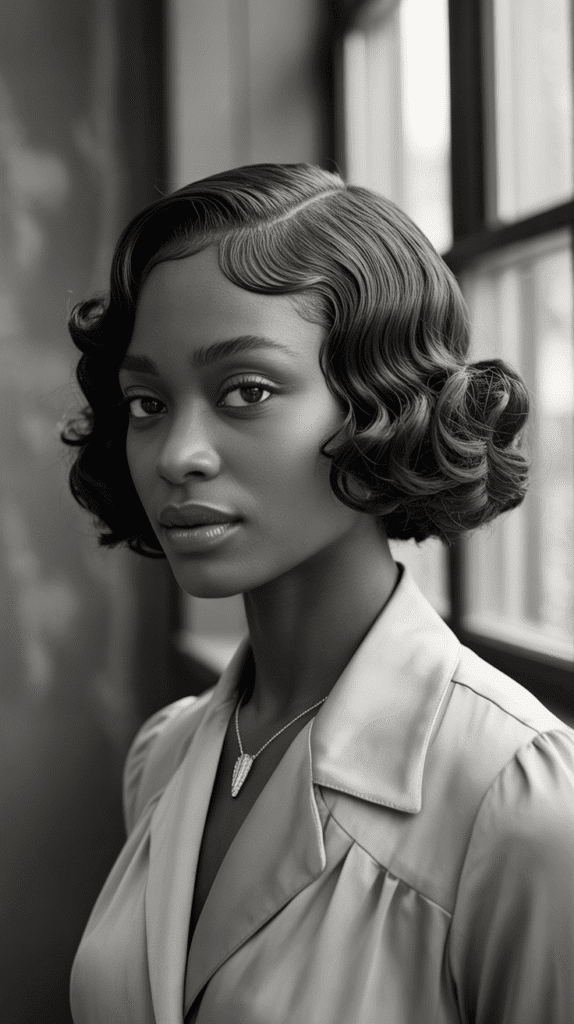
The faux bob allowed women with longer hair to experiment with the short, modern bob silhouette without committing to cutting their hair.
Pinned waves created the illusion of shorter length.
- Longer hair was tucked under and pinned at the nape to create the appearance of chin-length or shorter hair.
- The visible sections were styled in finger waves or marcel waves that mimicked authentic bob hairstyles.
- This technique gave women styling flexibility, allowing them to wear their hair long or short depending on mood and occasion.
- The faux bob was particularly popular among women who wanted to appear modern and fashionable while maintaining long hair for cultural or personal reasons.
- Creating a convincing faux bob required skill in securing the hidden hair smoothly so no bulk or bumps appeared.
- Bobby pins and hair grips were essential tools for maintaining the illusion throughout the day.
- This style represented the compromise many Black women made between traditional long hair preferences and modern beauty trends.
24. Center Part Marcel Waves with Low Ponytail
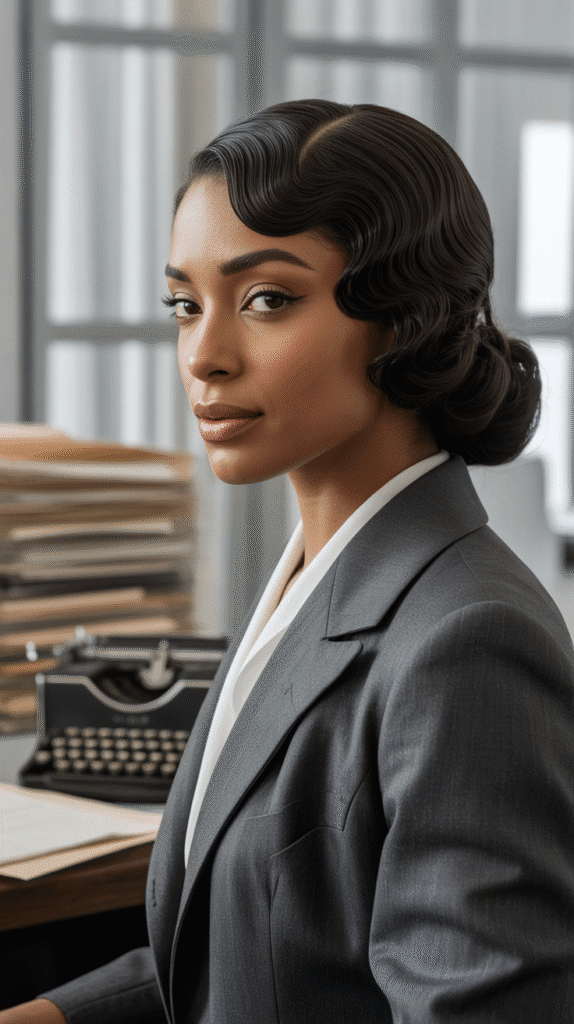
The combination of center part marcel waves with a low ponytail created a practical yet elegant style suitable for both work and social occasions.
This hybrid approach balanced beauty with functionality.
- The front and side sections featured marcel waves that provided the characteristic 1930s aesthetic.
- The remaining hair was gathered into a low ponytail at the nape, keeping it secure and manageable.
- The ponytail could be left natural, wrapped, or curled depending on desired formality and personal style.
- This style was particularly practical for women with active lifestyles or physically demanding work.
- The center part created facial symmetry and worked well with the balanced styling approach.
- Ribbons, fabric ties, or decorative holders secured the ponytail while adding visual interest.
- This approach demonstrated how Black women adapted formal styling techniques to meet practical everyday needs.
25. Spiral Pin Curls with Side Volume
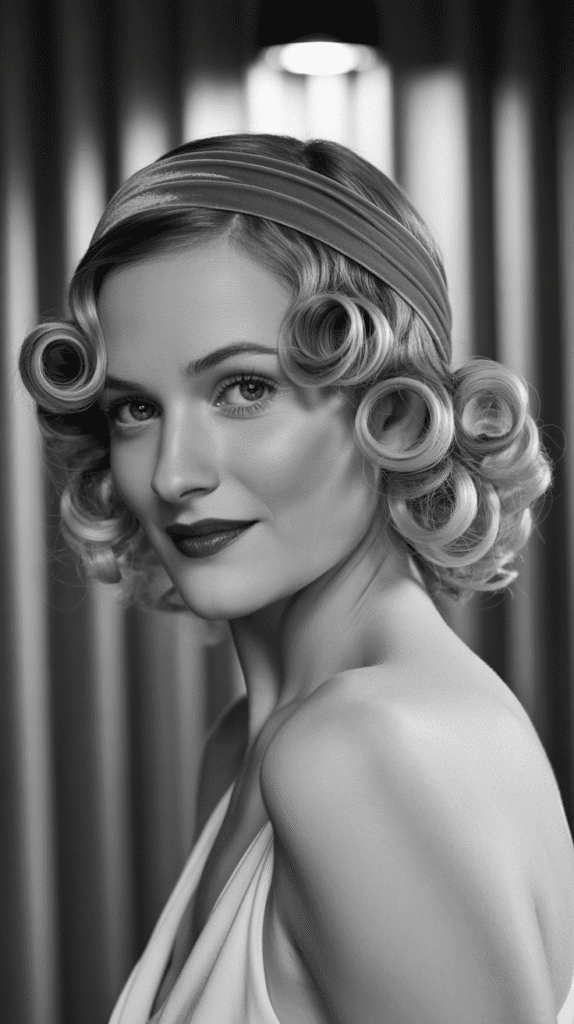
Spiral pin curls created more defined, springy curl patterns than traditional flat pin curls.
When arranged to create side volume, this style offered drama and dimension.
- Spiral pin curls were formed by standing the curl on its end rather than pinning it flat against the scalp.
- This technique created height and volume as the curls dried in an upright position.
- One side was styled with concentrated curl volume while the other remained smoother for contrast.
- The resulting style had bouncy, dimensional curls that moved naturally and caught light beautifully.
- This approach worked particularly well with Black hair textures that naturally held curl patterns.
- The volume created by spiral curls made thin or fine hair appear fuller and more luxurious.
- This style required careful sectioning and consistent curl direction to achieve a cohesive, polished appearance.
26. Wavy Bob with Curved Ends
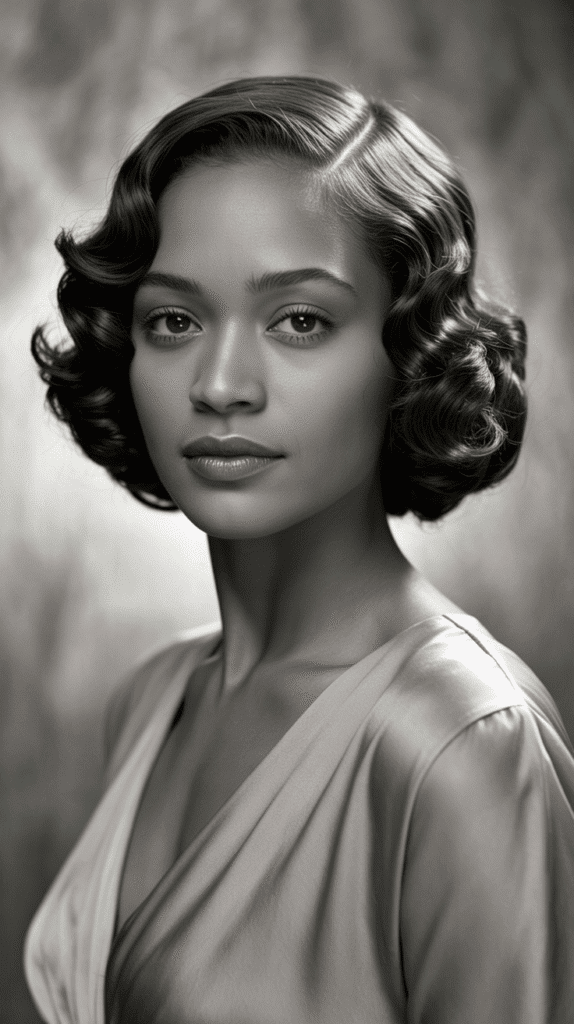
The wavy bob featured waves throughout the length with ends that curved under or outward, creating a polished, finished appearance.
This classic style embodied 1930s sophistication in its most accessible form.
- The bob length typically fell between the chin and shoulders, offering practical length with stylish appeal.
- Waves were formed using marcel irons or pin curls throughout the length, creating consistent texture.
- The ends were specifically styled to curve inward toward the neck or outward away from the face.
- This directional end styling added polish and prevented the style from appearing unfinished.
- The wavy bob was versatile enough for professional settings while remaining elegant for social occasions.
- Black women could achieve this style with various hair textures, though pressing was often used for smoother results.
- This remains one of the most recreated 1930s styles today due to its timeless appeal and wearability.
27. Theatrical Pin Curls with Dramatic Part
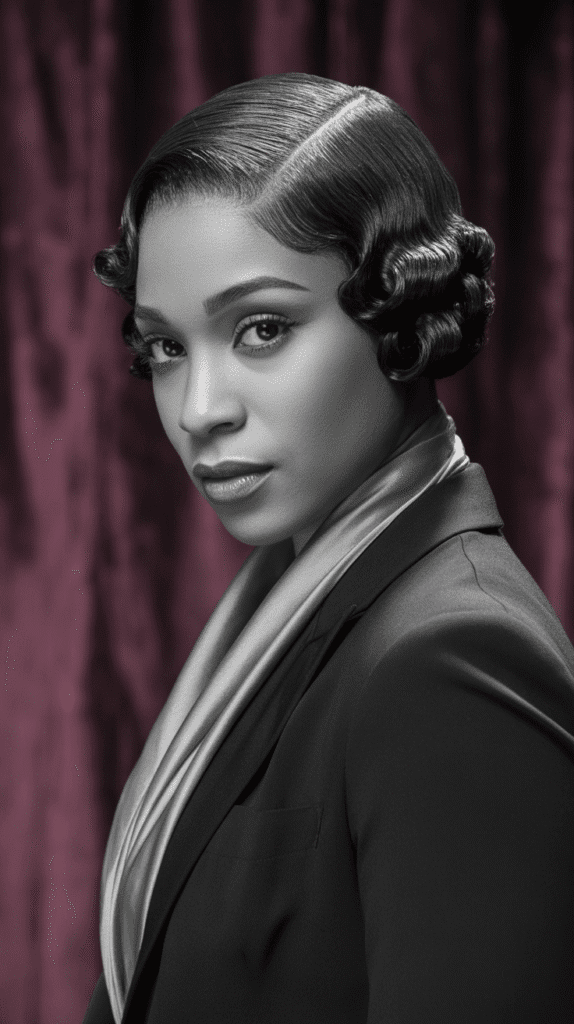
Theatrical styling took everyday pin curl techniques to dramatic extremes, creating bold looks suitable for performance and high-fashion settings.
The dramatic part emphasized the artistry of the style.
- The part was positioned in unexpected places or exaggerated in width to create striking visual impact.
- Pin curls were arranged in artistic patterns rather than uniform rows, creating designs visible from all angles.
- This approach was popular among performers, models, and women in creative industries within the Black community.
- The styling often incorporated multiple curl sizes and directions within a single design.
- These hairstyles pushed boundaries and challenged conventional beauty standards of the era.
- Theatrical styles required extended setting time and substantial product to maintain their dramatic shapes.
- This artistic approach to hair design influenced fashion photography and stage performance aesthetics of the 1930s.
28. Smooth Waves with Art Deco Hair Jewelry
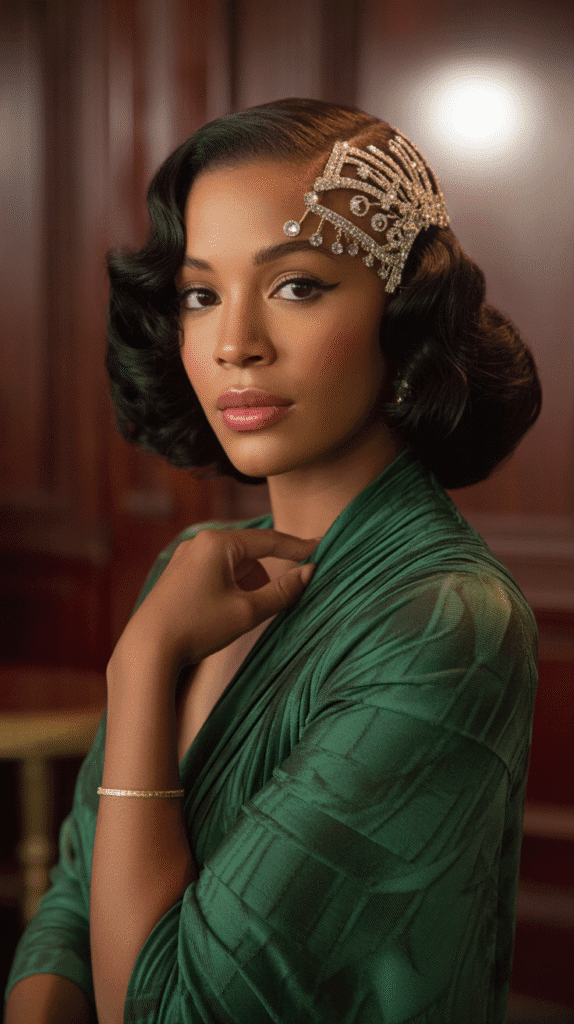
Art Deco hair jewelry transformed simple wave hairstyles into statement looks worthy of the era’s glamorous aesthetic.
These geometric accessories perfectly complemented the sculptural nature of 1930s waves.
- Hair jewelry featured Art Deco motifs including geometric shapes, stylized designs, and symmetrical patterns.
- Popular pieces included hair clips, barrettes, decorative pins, and chain-linked ornaments.
- These accessories were positioned to enhance wave patterns and add sparkle without overwhelming the hairstyle.
- Materials ranged from rhinestones and marcasite to enamel and chrome, reflecting Art Deco’s industrial influences.
- Black women wore these pieces for evening events, parties, and any occasion requiring elevated glamour.
- The jewelry placement was carefully considered to work with the natural flow of waves.
- These accessories represented the intersection of hairstyling and fashion jewelry design in 1930s culture.
29. Half-Up Waves with Back Cascade
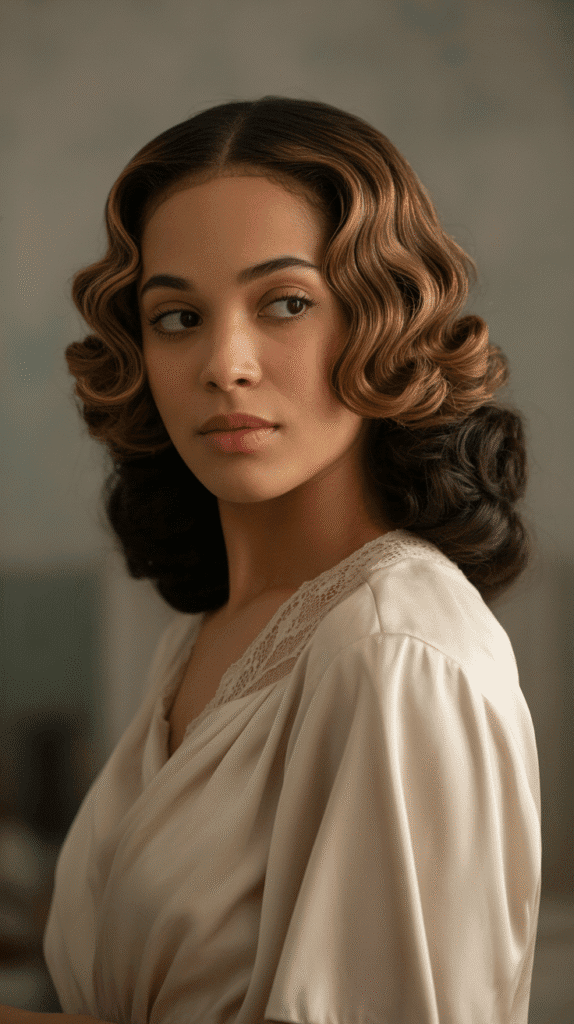
The half-up style secured the top sections while allowing bottom sections to cascade freely, creating a romantic look that balanced structure with movement.
This versatile style suited various occasions.
- The top and side sections were styled in waves and gathered at the crown or upper back.
- The remaining bottom sections were left to cascade down in loose waves or curls.
- This style worked particularly well for women with longer hair who wanted to showcase length while keeping hair off the face.
- The secured sections could be pinned with decorative accessories or hidden pins depending on desired formality.
- This approach provided face-framing benefits while maintaining the feminine appeal of flowing hair.
- Black women often curled or waved the cascading sections for cohesive styling from top to bottom.
- The style offered practical benefits for warm weather while maintaining romantic, elegant aesthetics.
30. Crown Braids with Finger Wave Sides
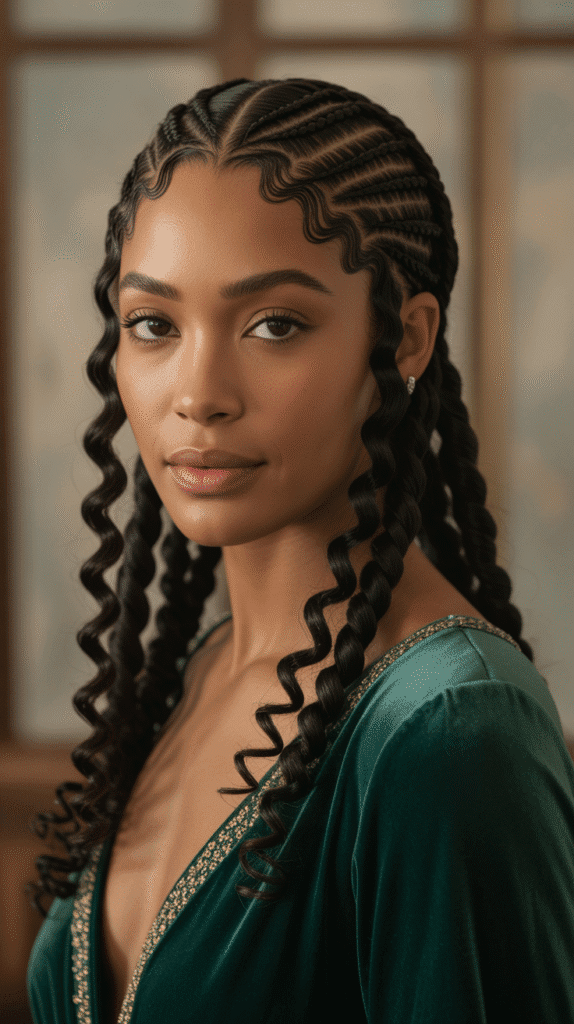
Crown braids incorporated traditional African braiding techniques into 1930s styling, creating cultural fusion hairstyles that honored heritage while embracing contemporary fashion.
Finger wave sides provided era-appropriate styling.
- Multiple small braids were arranged around the crown area in circular or geometric patterns.
- The side sections featured traditional finger waves that integrated seamlessly with the braided crown.
- This style celebrated Black hair traditions while participating in mainstream 1930s beauty culture.
- The braiding provided texture and dimension that contrasted beautifully with smooth, sculpted waves.
- This approach allowed women to wear protective braiding styles while maintaining fashionable appearances.
- The combination demonstrated the creative ways Black women adapted prevailing trends to suit their needs and preferences.
- This style represented resistance to assimilation while engaging with popular beauty standards of the era.
Styling Products and Techniques of the 1930s
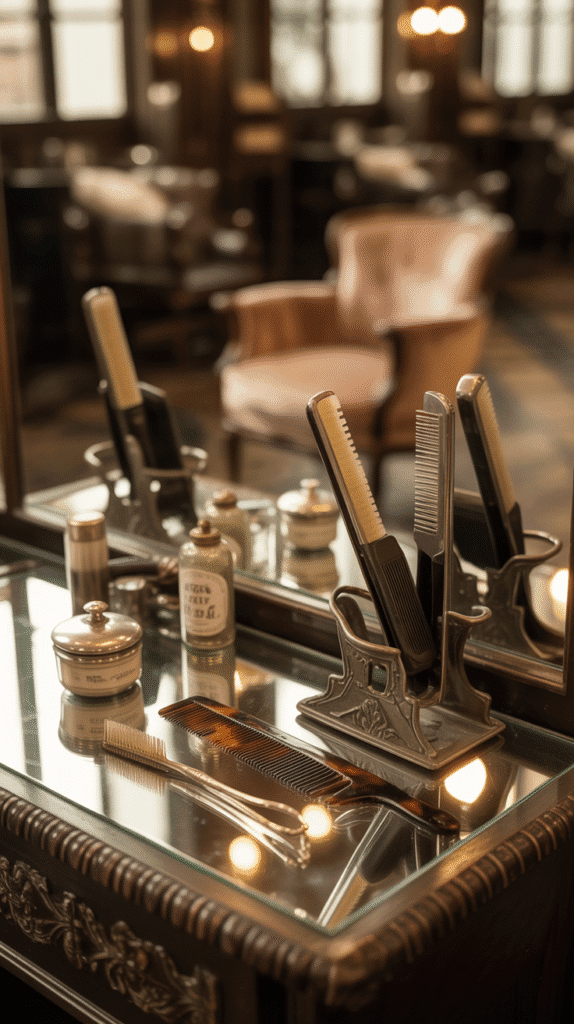
- Hair pomades were the essential styling product of the 1930s, providing hold, shine, and moldability for sculpting waves and curls.
- Setting lotions made from flaxseed, sugar water, or commercial preparations helped waves maintain their shape as hair dried.
- Hot combs and pressing irons were used to straighten hair before styling, allowing for smoother wave formation and sleeker finishes.
- Marcel irons, heated on stoves or specialized heaters, created the signature marcel waves that defined the era’s aesthetic.
- Wave clips, also called finger wave clips, held waves in place during the drying process to ensure crisp, defined S-curves.
- Bobby pins and hairpins were indispensable tools for securing pin curls, updos, and decorative elements throughout hairstyles.
- Silk or satin wave caps protected overnight sets and helped maintain moisture in Black hair while styles developed.
- Wide-toothed combs and specialized wave combs helped create the grooves and ridges necessary for perfect finger waves.
- Brush techniques varied from smoothing brushes for sleek sections to softer brushes for blending out pin curls into waves.
- Modern recreations can substitute vintage products with contemporary styling gels, mousses, and heat protectants while maintaining authentic appearances.
Hair Care Practices for Maintaining 1930s Styles
Maintaining the health and beauty of hair while achieving 1930s styles required specific care practices that Black women developed and refined throughout the decade.
- Hot oil treatments using natural oils like coconut, olive, or castor oil nourished hair and scalp between styling sessions.
- Hair was typically washed weekly or bi-weekly to prevent excessive dryness that could result from frequent manipulation and pressing.
- Scalp massage techniques promoted circulation and healthy hair growth while distributing natural oils throughout the hair shaft.
- Protective nighttime routines included wrapping hair in silk or satin scarves to maintain waves and prevent friction damage.
- Deep conditioning with homemade treatments containing eggs, mayonnaise, or avocado helped restore moisture and protein.
- Trimming ends regularly prevented split ends and maintained the clean lines essential for polished 1930s silhouettes.
- Limiting heat exposure when possible by air-drying pin curls and using lower temperatures on pressing tools protected hair integrity.
- Drinking adequate water and maintaining nutritious diets supported hair health from within, creating stronger, more manageable hair.
- Using gentle manipulation techniques when styling reduced breakage and allowed for longer, healthier hair growth.
- These practices created the foundation for beautiful styles while ensuring hair remained healthy and strong over time.
Cultural Significance of 1930s Hairstyles in Black Communities
The hairstyles of the 1930s held profound cultural meaning within Black communities, representing more than mere fashion statements but rather expressions of identity, resistance, and aspiration.
- These hairstyles represented Black women’s participation in mainstream beauty culture while maintaining distinct cultural identity and style preferences.
- The Great Migration brought Southern Black communities to Northern cities, where new beauty standards and techniques merged with traditional practices.
- Black-owned beauty salons became important community gathering spaces where women shared news, built relationships, and supported each other.
- Madam C.J. Walker’s legacy continued influencing Black beauty culture, with her hair care products and business model inspiring entrepreneurship.
- Hairstyling skills provided economic opportunities for Black women through salon ownership, home-based businesses, and domestic work.
- These styles challenged racist beauty standards that devalued Black features while demonstrating sophistication and refinement.
- The Harlem Renaissance celebrated Black beauty and culture, with hairstyles reflecting the era’s artistic and intellectual flowering.
- Church communities particularly valued neat, elegant hairstyles as expressions of respectability and spiritual devotion.
- Film and entertainment industries showcased Black performers whose hairstyles influenced community trends and aspirations.
- These hairstyles represented resilience and creativity during economically challenging Depression-era circumstances, demonstrating beauty’s importance even in hardship.
Modern Recreations and Contemporary Adaptations
Today’s hairstylists and vintage enthusiasts continue finding inspiration in 1930s Black hairstyles, adapting historical techniques for contemporary contexts while honoring their origins.
- Modern styling products like edge control, setting gels, and heat protectants make achieving vintage looks easier while protecting hair health.
- YouTube tutorials and social media platforms have democratized access to 1930s styling techniques, allowing widespread learning and experimentation.
- Wedding hairstylists frequently incorporate 1930s elements into bridal looks, creating timeless elegance for special occasions.
- Natural hair movements have inspired adaptations that work with unprocessed hair textures while maintaining vintage aesthetics.
- Vintage fashion events, themed parties, and historical reenactments create opportunities for wearing authentic 1930s-inspired hairstyles.
- Professional photographers specializing in vintage portraiture help clients achieve period-accurate looks for artistic projects.
- Fashion editorials regularly reference 1930s hairstyles, bringing historical techniques into contemporary high-fashion contexts.
- Protective styling approaches incorporate 1930s elements like pin curls and waves while minimizing heat and chemical processing.
- Cosmetology schools sometimes include vintage techniques in curricula, ensuring these skills pass to new generations of stylists.
- The enduring appeal of these hairstyles demonstrates their timeless elegance and the lasting influence of 1930s Black beauty culture.
Famous Black Women Who Wore 1930s Hairstyles
Several prominent Black women of the 1930s wore these elegant hairstyles, influencing beauty standards and inspiring countless others through their public visibility and style.
- Josephine Baker, the internationally famous entertainer, wore sleek finger waves that became iconic symbols of Jazz Age glamour and sophistication.
- Ethel Waters, renowned singer and actress, showcased elegant marcel waves and sophisticated updos both on stage and in films.
- Bessie Smith, the Empress of the Blues, wore finger waves and decorative hair accessories that complemented her powerful stage presence.
- Fredi Washington, actress and civil rights activist, wore polished finger waves that highlighted her striking features in films.
- Nina Mae McKinney, one of the first Black film stars, popularized short, waved hairstyles that challenged conventional beauty standards.
- Billie Holiday, beginning her career in the late 1930s, wore elegant waves adorned with her signature gardenias.
- Dorothy Dandridge, as a young performer in the 1930s, wore age-appropriate pin curls and waves that evolved with her career.
- Adelaide Hall, British-based jazz singer, wore sophisticated finger waves that influenced both American and European beauty trends.
- These women’s visibility in entertainment, activism, and public life elevated 1930s hairstyles to aspirational status within Black communities.
- Their style choices demonstrated that Black women could embody elegance, sophistication, and beauty on international stages.
Tips for Achieving Authentic 1930s Looks Today
Creating authentic 1930s-inspired hairstyles today requires understanding both historical techniques and modern adaptations that protect hair while achieving vintage aesthetics.
- Begin with clean, conditioned hair that has been properly moisturized to create a healthy foundation for styling.
- Practice finger wave techniques on small sections first before attempting full hairstyles to develop muscle memory and consistency.
- Invest in quality tools including rat-tail combs, wave clips, and bobby pins that match those used historically for authentic results.
- Use modern heat protectants before applying any hot tools to prevent damage while achieving sleek, pressed finishes.
- Allow adequate drying time for set styles—rushing the process results in dropped curls and undefined waves that lack longevity.
- Study vintage photographs and film footage to understand how light, shadow, and movement affected the appearance of these hairstyles.
- Consider face shape when selecting which 1930s style to recreate, as certain styles flatter different features more effectively.
- Don’t be discouraged by initial attempts—historical hairstylists spent years perfecting these techniques through daily practice.
- Adapt vintage techniques to work with your natural hair texture rather than fighting against it for healthier, more sustainable results.
- Remember that 1930s hairstyles were meant to be elegant but also livable, so choose styles appropriate for your lifestyle and maintenance preferences.
The Role of Black Beauty Salons in 1930s Culture
Black-owned beauty salons served as crucial cultural institutions during the 1930s, providing far more than hairstyling services to their communities.
- These salons functioned as safe spaces where Black women gathered, socialized, and built supportive networks away from discriminatory environments.
- Beauty culture provided economic independence for Black women entrepreneurs who owned and operated successful salon businesses.
- Salons served as informal employment agencies where women learned about job opportunities through community networks and conversations.
- Political organizing and civil rights discussions often occurred in salon settings where community leaders could reach engaged audiences.
- The skills taught in these salons passed from generation to generation, preserving techniques and building professional legacies.
- Salons stocked specialized products designed for Black hair, creating markets for Black-owned beauty product companies and manufacturers.
- These businesses demonstrated Black excellence and professionalism, countering racist stereotypes through impeccable service and sophisticated environments.
- Church communities often connected through salon networks, with stylists preparing members for Sunday services and special occasions.
- Young girls learned beauty culture and business acumen by observing and assisting in family salon operations.
- The social importance of these spaces cannot be overstated—they were democratic institutions where all Black women, regardless of class, could access beauty services and community connection.
Comparing 1930s Hairstyles Across Different Regions
Regional variations in 1930s Black hairstyles reflected local cultures, economic conditions, and the diverse experiences of Black communities across America.
- Urban Northern cities like New York, Chicago, and Detroit featured more fashion-forward styles influenced by entertainment industries and European trends.
- Southern communities often maintained longer hair lengths and incorporated more traditional elements alongside contemporary wave techniques.
- West Coast cities like Los Angeles developed distinct styles influenced by Hollywood glamour and growing film industry connections.
- Rural areas adapted 1930s trends based on available products, tools, and access to trained stylists, often creating innovative local variations.
- Economic differences between regions affected styling frequency, with wealthier urban areas supporting more frequent salon visits.
- Climate considerations influenced styling choices, with humid Southern regions requiring different products and techniques than drier Western areas.
- Migration patterns brought Southern styling traditions to Northern cities, creating cultural exchanges that enriched beauty practices in both regions.
- Port cities with international connections sometimes incorporated Caribbean and Latin American influences into their styling approaches.
- College towns and areas with historically Black colleges and universities often featured styles influenced by educated, professional communities.
- These regional variations demonstrated the diversity within Black communities and the creative adaptations women made to suit their specific circumstances.
The Intersection of Fashion and Hairstyling in the 1930s
Hairstyles and fashion worked together to create cohesive looks that defined 1930s elegance, with each element carefully considered to complement the other.
- Bias-cut evening gowns popular in the 1930s were beautifully complemented by sleek finger waves that echoed the garments’ fluid lines.
- Cloche hats required specific hairstyles that fit underneath while maintaining shape, influencing shorter cuts and close-set waves.
- Art Deco jewelry and accessories featured geometric designs that harmonized with the sculptural quality of finger waves and pin curls.
- Daytime suits with broad shoulders balanced visually with upswept hairstyles that added height and maintained proportional silhouettes.
- Fur stoles and elegant wraps were showcased effectively when paired with updos that revealed the neck and shoulders.
- Glove lengths influenced hairstyle choices for formal events, with longer gloves typically paired with more elaborate hair arrangements.
- Neckline shapes guided hairstyle selection—high necklines paired with updos while lower necklines often featured loose, flowing styles.
- Hat styles changed throughout the decade, requiring women to adapt their hairstyles to accommodate millinery trends.
- Costume jewelry grew popular during the Depression, with hair accessories becoming affordable ways to elevate simpler hairstyles.
- This integration of fashion and hair demonstrated the holistic approach Black women took to creating elegant, cohesive presentations.
Conclusion
The journey through 30 Beautiful 1930s Hairstyles for Black Women That Inspire Grace reveals far more than vintage beauty techniques—it uncovers a rich tapestry of cultural resilience, artistic innovation, and timeless elegance.
These hairstyles represented Black women’s determination to claim space in beauty culture while maintaining their dignity and identity during challenging times.
From the precise sculptural beauty of finger waves to the romantic flow of cascading curls, each style tells stories of creativity, skill, and pride that transcended economic hardship and social limitations.
The techniques developed by Black hairstylists in the 1930s continue influencing contemporary beauty culture, proving that true elegance never fades.
Whether you’re recreating these styles for special occasions, studying beauty history, or simply appreciating the artistry of a bygone era, these 30 hairstyles offer endless inspiration.
They remind us that beauty is both personal expression and cultural statement, that grace can flourish in any circumstance, and that the legacy of Black women’s creativity continues shaping how we understand elegance today.
May these stunning 1930s hairstyles inspire you to explore vintage beauty with appreciation for the remarkable women who wore them with pride, dignity, and incomparable style.
